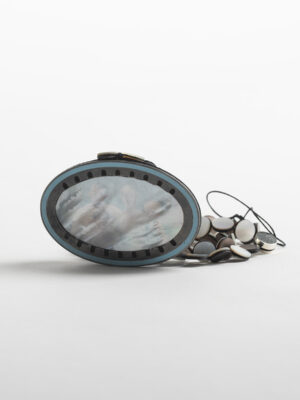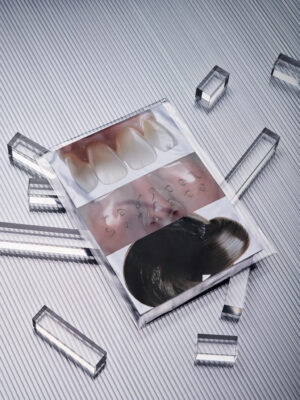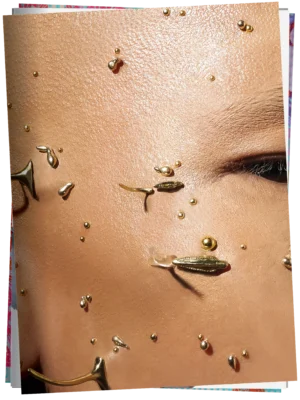Philipp Eberle

FAKE
Rings, 750/00 Gold
The word FAKE describes a discrepancy between appearance and content. It describes the relationship between original and FAKE. The proverb ‘Appearances deceive’ sums it up and serves as a starting point for my work. Even though many products from our everyday life appear valuable, this assumption is not always justified, once we give them a closer look. We purchase goods for a cheap price, despite the fact that they look expensive. Our life is fraught with artificial leather and artificial wood. Jewellery – the acme of luxury – excels in this discipline: It is the world champion in pretending to be something valuable. For my work, I have been drawing on this conclusion, while similarly inverting its meaning: My ‘FA KE’ rings are not what they say they are either. They are expensive and valuable. Made of 18-carat gold and manufactured by a jewellery goldsmith in Germany, the signet rings’ literal statement (FA KE) plays with its own absurdity. Likewise, the idea behind my label ‘The Lettering’ is to question exactly these boundaries between form and function, and to highlight the relation between jewellery and typography. The FAKE rings correspond to this notion: The letters are the jewellery.
Rainer Kaasik-Aaslav

GOD OF NATURAL INSTINCTS
Shungite, buffalo horn, artificial ruby, silver
ALTAR OF IGNORANCE
Object, Wood, lacquer
GOD WHO LEFT
Object, Artificial marble, artificial ruby
I think of FAKE as a form of hypocrisy. FAKE is within human nature, so it is perhaps not entirely bad. In this sense, the Russian saying “Pray to the God, but don’t forget to light a candle for Devil” applies to all of us. My work for this project comprises three pieces that play with this FAKE hypocrisy: The material used in the ‘God Piece’ is FAKE, as it consists of artificial marble and artificial ruby. It projects the idea of humanities’ virtuous achievements being revealed as FAKE, as well as it suggests a tendency of constructed ideals, which we pretend to chase. The ‘Devil Piece’ evokes a notion of effortlessness, as it refers to Christianity’s conception of the devil being a symbol for fast and easy access to individual goals. This concept is very natural for human behaviour: Everybody wants to be rich or famous, to be good at something. Many of us might hope for an easy advancement to appear, while similarly knowing that there is no such thing. This is the duality of human nature, reflected in the Russian saying. ‘Altarpiece’, the third part of the work’s trilogy, refers to a classical Calvary scene – the white marble cross, however, remains empty.
Adam Grinovich

HILT
Brooch, MDF, imitation gold leaf, steel
DECORATIVE FORM 1
Object, MDF, imitation gold leaf
“When I grew up, I chose to adhere to subcultures that stressed the genuine, the true, the strong, the real. ‘Posers’ were considered to be counterfeit people who sneaked into our culture, our music, our way of life. Because we – obviously – regarded ourselves as ‘real’. I find this notion of FAKE especially interesting, since it relates to dangerous ideologies of supremacy and purity — ideologies that are mirrored in various different types of (sub) culture. As my work has the tendency to revolve around surfaces, I chose for this project to experiment with material imitating gold leaf. The relationship is fairly obvious: firstly, gold leaf is, in and of itself, a sort of disingenuous form of ornamentation—it is a thin layer of film, that creates an effect of precious metal. Secondly, I am choosing not to use real gold leaf, but a composite of cheaper metals evoking the effect of gold. Therefore, it is essentially a twofold forgery. These works lie within the realm of the paradoxical, since I consider a good piece of work to be an honest one—to be true and real, as far as it expresses the creator’s ideas in a direct and genuine way. I borrow greatly from the field of contemporary sculpture, as I choose to see jewellery as a craft in which everything is possible, everything is available and nothing is holy.”
Barbara Schrobenhauser

GOLDEN MYTH
Various materials, Various sizes
When I hear the term FAKE I think of deception or fraud. It provokes the notion of imitation and irritation. This is also interesting in regard to my work, as I deal with materials, trying to see them from a different perspective. I also encourage the viewers to engage in my works’ materiality, so that they can learn more about it through a closer examination and by touch. Instead of wanting them to be fooled, I motivate them to make their own experience. Relating the subject of FAKE to my profession as a goldsmith, I assembled and looked into materials and things that mime the myth of gold, subsequently creating jewellery from this collection. This process was very exciting, as there are many materials to explore, which are used to imitate and to surrogate gold – they are products that are part of a sales strategy, caused by industrialisation. Therefore, I created one assemblage of products that could be characterised as the ‘golden strategy’ and, additionally, another one with materials that are in fact ‘golden’. I made the jewellery from these two standpoints, acting completely intuitively and spontaneously. The work is simply a collection of various pieces of jewellery that are gold.
Florian Weichsberger

CAVUPATHILEM
Pendant, plastic
CAVOROK
Pendant, plastic
A FAKE implies the existence of a model or an original. It is an imitation or a copy of something that is desirable, ideal or unreachable. Something that we would like to own (a product) or that we would like to become (a role model). What I find particularly interesting is the moment in which the FAKE outplays its original, as it happens at times, for example, in art forgery or with virtual identities. Once the FAKE is no longer doubted and once it seems flawless, it evokes a reverse process, in which the FAKE substitutes the original. In regard to these processes my work concerns questions of reality and thus it investigates the interrelation between fragmentary memories, (assumed) knowledge, imagination and fantasy. Inspired by tools and minerals from the Stone Age, I tried to approach the particular aesthetics without imitating them. The result, which solely emerged from my imagination, resembles the appearance of something antique or a rock, however quickly disclosing several ‘flaws’: The weight, the surface, the casting seams to reveal the pieces’ identity. They are casts of plastic, poured into a form of a prepared massive silicone block. The black piece additionally comprises glass stones, which turned out as glossy ‘bubbles’, looking like enclaves or pebble stones.
Florian Milker

CANDY#1
Brooch, Nylon, paint, silver, steel
GOLD#1
Brooch, Nylon, paint, silver, steel
BLUE#2
Brooch, Nylon, paint, silver, steel
“FAKE makes me think of plagiarism, like the fancy Lacoste Polo-shirt from the last holiday in Tunisia or the cheap iPhone from the China market in Poland. Still, we are not just faking for economical reasons. The communicative matters are much more intriguing: In the novel The Great Gatsby from F. Scott Fitzgerald the stranded protagonist uses the property of others to brag in front of a crowd that he wishes to attract. This story highlights a sense of ownership that enables the character to receive attention. Within the field of jewellery, a commodity that serves as pure adornment, FAKE is often found where imitation of form and material are common. “Not all that glitters is gold”. The question of truth comes to mind. Especially in the appearance of the self and others, FAKE is an everlasting game between perception and mind. But how does it look like, when vanity takes form? This thought is also reflected in my contributed works: The core of these objects consists of moulded components, placed into a bra, as to optimise form and size of the breasts. The moulded forms are created with CAD-modeling (Computer Aided Design), printed on nylon. Emphasising the appearance of different surfaces, it is a common technique particularly used in the automotive industry, but also in various art and design contexts.”
Jing He

Attachments – Malaysian Jade
Readymade (Malaysian jade bangle, jewel box, price tag, certificate), pigment
“If FAKE is an object, it is about pretending. FAKE can also be a non-object: it can be a fiction, a story that has never happened. Malaysian Jade is a combination of fake material and fiction: It first appeared in the 1980s at the border between China and Burma – a renowned market place for jade. The Malaysian Jade has a uniform-green colour and a translucent gloss, which is considered a sign for high quality. Indian and Pakistan businessmen used to sell it, claiming that this type of jade originated from Malaysia, while in fact, it is a dyed quartzite. Even today the so-called Natural Malaysian Jade is paradoxically advertised with the exact same strategy.
One the one hand, I am interested in how this fake description became a common term 30 years after the product’s appearance on the market, and how this is related to the disastrous, economical implications for the individual customers, who believed that they would invested in jade. On the other hand, I am interested in the particular colour of Malaysian Jade and researched its composition. For this project, I bought a Malaysian Jade bangle, which came with a jewellery box, a certificate containing wrong information and a fake price tag. I withdrew the green pigment with acid and extracted it into a solid substance. Afterwards I formed the extract into a small bump and placed it back onto the bangle, so that the original pigment component transformed into an exterior attachment. The price tag is still pinned to the bangle. It says 1880 RMB, which equals 218 Euros. I paid 8 Euros.”
Mallory Weston

GOLDEN SAGUARO CACTUS
Brooch, Gold-plated copper, brass, nickel, cotton, polyester
GOLDEN CRYING CACTUS
Necklace, Gold-plated copper, leather, cotton, polyester
FAKE to me, is an imitation of something that is real. Moreover, it is an imitation that is doing a poor job convincing anyone. Perhaps, most people would consider something that is FAKE as a bad thing. But I think there is beauty in things that are blatant rip-offs, such as the unnatural colouring and textures of fake flowers, or the garish over-the-top opulence of gilded decor. For this exhibition, I made two cactus pieces, which are fakes of the real objects. Although they seem to be unrealistic, they are not necessarily unreal. I gold-plated all of the metal that I used, giving it the appearance of wealth. In reality, however, it is just a superficial layer, concealing the copper underneath. Picking up the exhibition’s title, I also chose the technique of gold plating, as to create a blinding assault on the eyes, caused by the faceted gold surface of the pieces. Playing with the objects’ reflections and also exploring the form of the cactus was interesting for me. Even though I have never gold plated any of the pieces that I have stitched onto fabric before, I consider the two cactus objects a continuation of my past work.
Julia Walter

FACE
Necklace, Galalith
SMILE
Necklace, Galalith
Who decides if something is FAKE or real? The mind does. I might believe that I live in a good world, while others live in hell. I might own something precious that others consider worthless. I might think I am pretty, while others think I am ugly. What is really true? I found a crystal and when I carry it in my pocket I gain superpowers. I am naive sometimes. We cannot do anything about it. FAKE does not exist. Everything is real. In regard to the theme, my contributed work is an ironic comment on fake emotions, such as fake smiles, fake tears, fake orgasms. I wonder: Can we really feign our emotions? While initially searching for something new, I instead found an old, an almost forgotten material: Galalith is made from milk, but it can pretend to be ivory, mother of pearl, jade, coral, ebony or horn. It is beautiful to work with this material. Touching it feels like putting one’s fingers on something between horn and rock, neither cold nor warm, but organic. I currently also enjoy to create graphic objects, for which I select drawings, cut out different shapes and make collages from paper until I find the right combination of form and colour to create a piece of jewellery. The finished objects look clean from a distance, but if they are approached closely, they reveal a hand-made character. I want it to be obvious that a person made this and not a machine.
Kevin Hughes

AN ENTHUSIASTIC CARROT
Brooch, Found objects, painted brass
“FAKE has many negative connotations, yet people forget that FAKE has a positive side. Many early childhood memories are related to FAKE processes and ‘make-believe’. Children love FAKE: they vacuum with a fake vacuum cleaner or play with fake musical instruments. FAKE is part of growing up, helping to foster experiences for adult life. FAKE is a learning tool, teaching how to hold a screwdriver or a guitar, or how a lawn mower works. I see a FAKE not only as positive, but also as fun and humorous – as toy like. And it is in this manner that I approached the construction of ‘An Enthusiastic Carrot’. Enthusiastic, because it is happy to be here, happy to be a source of joy, happy to be FAKE. Made from plastic, its surface is smooth and clean. The form of the brooch is controlled and exact, the colours are vibrant. There is no pretence, no deception – the carrot is FAKE!”
Sophie Hanagarth

FORTUNA
Box and rings, beeswax, gilt silver, brass
“To me, FAKE is first and foremost any superfluous object,any product that is subject to overblown consumption. Every dream-wrapped object – from fashion or image, to colour or smell – is a part of a general anaesthesia of the human mass; a loss of autonomy and free will: dictatorships, utopias and free market capitalism. FAKE today, in the world of jewellery and accessories, has to do with a very superficial idea of luxury: Famous labels demonstrate their great respect for craftsmanship, while actually, these creations suggest using jewels as ostentatious objects. Several of my works are variations of FAKE: Brooches of Honour (‘Shitty Medals’), testicle-necklaces (‘Family Jewels’), a keyring for the index finger (‘Blacklisting’) or sucking-mouth-rings (‘Lipstick’) are types of objects which are build upon images of reality. The objects transform themselves into something poetic or condemn them: they are surrealistic parodies. For this exhibition, I reproduced excrement in form of plastic faeces, as pure as the sculptures produced naturally by our own bodies. Excrement has no value: it is biodegradable and something that we are not keen on touching. I have made it more tangible by casting it in the noble metal of gilt silver. This may appear as an absurd transformation, but as a matter of fact, this process – turning excrement, that is to say, shit into gold – is the work of the alchemists, to whom many jewellery makers feel quite close. What interests me most about these objects, is the fact that excrement acts as a good luck charm, that can be carried in the pocket. To summon good luck, I like to
call these objects ‘Fortuna’ – another illusion.”
Edgar Mosa

SHOE LACE
Rope, Oxidized brass
JUMP RING
Brass
DIAMOND
Glass
EYEGLASS WIPE
Cloth, Flocked canvas
“FAKE takes many forms, such as assimilation and disbelief. A FAKE cannot exist without an original – an object to compare it to as unauthentic, to manifest its existence as a replica, an imitation. FAKE takes place when a design object loses the purpose it is meant to serve. It thus becomes a prop, if it is still useful, or an object of art, if it is useless altogether. René Magritte dignified the FAKE eternally with an image of a pipe. FAKE may emerge as a failure of proof and this might turn FAKE into poetry. “[…] as long as nothing happens between them, the memory is cursed with what hasn’t happened.”* Considering the collaboration between Depot Basel (a place for contemporary design and haptic exhibitions) and Current Obsession Magazine (a publisher of images and non-haptic objects) I chose to dedicate my contribution to this particular dual life of the object – its existence and its picture. Thus, I have re-created objects that do not exist, despite appearing real in images. The large dimensions of these objects withdraws their purpose: A jump-ring becomes a bracelet; a shoelace becomes a jump rope; an eyeglass wipe cloth becomes a tablecloth; and a diamond remains the shiny rock that it is, regardless of its use or function. It is a collection that accentuates an implied illusion, it retains a context of jewellery and it depicts objects that flirt with my day-to-day experiences.”
* “Blue Eyes, Black Hair”, Marguerite Duras


DEPOT BASEL, space for contemporary design and CURRENT OBSESSION, contemporary jewellery magazine, present a collaborative curatorial effort in the context of Depot Basel’s ongoing exhibition series ‘CRAFT &…’.For CRAFT & BLING BLING ‘FAKE’ they commissioned work by twelve jewellery makers reflecting on the subject of ‚FAKE‘ from standpoints of jewellery history, their own work mediums or contemporary art and society.
Work by Manfred Nisslmüller, Suska Mackert, Johanna Dahm and Cloe Floirat accompany the exhibition. The exhibition becomes a feature in the #3 FAKE issue of the CURRENT OBSESSION magazine accompanied by Thomas Albdorf‘s photographs.
JEWELLERY MAKERS Adam Grinovich, Barbara Schrobenhauser, Edgar Mosa, Florian Milker, Florian Weichsberger, Jing He, Julia Walter (Ju Walter), Kevin Hughes, Mallory Weston, Philip Eberle, Rainer Kaasik-Aaslav, Sophie Hanagarth


